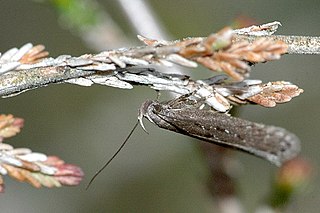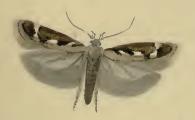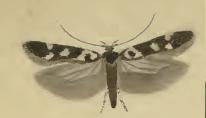
Neofaculta ericetella is a moth of the family Gelechiidae. It is found in Europe and Asia Minor.

Chrysoesthia sexguttella, the orache leafminer moth, is a moth in the family Gelechiidae. It is found in all of Europe, east to southern Siberia, as well as the north-eastern parts of North America, where it might be an introduced species.

The lobster-clawed moth is a moth of the family Gelechiidae. It is found in most of Europe, except for the Iberian Peninsula and most of the Balkan Peninsula. In the east, the range extends to Siberia and Taiwan.

Monochroa lucidella is a moth of the family Gelechiidae. It is found in most of Europe, except Spain, Switzerland and most of the Balkan Peninsula. It is recorded from the Near East and Siberia (Transbaikalia).

Caryocolum fraternella is a moth of the family Gelechiidae. It is found in Ireland, Great Britain, Fennoscandia, Denmark, Germany, the Netherlands, France, Switzerland, Spain, Latvia, Estonia and Ukraine.

Caryocolum marmorea is a moth of the family Gelechiidae. It is found from Scandinavia to the Mediterranean islands, and from Ireland to Poland, Hungary and Greece. It is also found on the Canary Islands and Madeira. It is also found in North America.

Caryocolum tricolorella is a moth of the family Gelechiidae. It is found from Fennoscandia to the Pyrenees, Alps and Romania and from Ireland to Russia and Ukraine.

Caryocolum vicinella is a moth of the family Gelechiidae. It is found in most of Europe, eastwards to the southern Ural.

Carpatolechia decorella is a moth of the family Gelechiidae. It is found in most of Europe, as well as in Turkey, the Caucasus, Kazakhstan, North Africa and on the Canary Islands.

Aproaerema anthyllidella is a moth of the family Gelechiidae. It is found in most of Europe, Kyrgyzstan, Iran and North America.

Apodia bifractella is a moth of the family Gelechiidae. It is found in most of Europe, as well as Turkey, the Caucasus and North Africa.

Helcystogramma rufescens is a moth of the family Gelechiidae. It is found in most of Europe.

Bryotropha domestica is a moth of the family Gelechiidae. It is found from Ireland to Germany, Slovakia, Romania and Bulgaria and from the Benelux to the Iberian Peninsula, Sicily, Crete and Cyprus. It is also found in Morocco, Algeria, Tunisia, Libya, the Middle East, Turkmenistan, Saudi Arabia and Yemen.

Bryotropha affinis is a moth of the family Gelechiidae. It is found in most of Europe.

Mirificarma mulinella is a moth of the family Gelechiidae. It is found in most of Europe, except Finland, the Baltic region and part of the Balkan Peninsula. It has also been recorded from North Africa.
Monochroa suffusella, the notch wing neb, is a moth of the family Gelechiidae. It is found from Fennoscandia to the Pyrenees and Alps and from Ireland to Romania. In the east, the range extends to Japan. The habitat consists of bogs, fens, swamps and salt-marshes.

Metzneria metzneriella is a moth of the family Gelechiidae. It is widely distributed throughout Europe, as well as Turkey and southern Siberia. The habitat consists of dry pastures and calcareous soils.

Gelechia rhombella, the apple groundling, is a moth of the family Gelechiidae. It is found in Europe, the Caucasus, Transcaucasia, southern Siberia, the Russian Far East, Korea and China.

Gelechia sororculella, the dark-striped groundling, is a moth of the family Gelechiidae. It is widely distributed from Europe, throughout Siberia to the Russian Far East.

Eulamprotes atrella, the two-spotted neb, is a moth of the family Gelechiidae. It was described by Michael Denis and Ignaz Schiffermüller in 1775. It is found from most of Europe, east to Japan. The habitat consists of mixed deciduous woodlands.

















